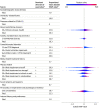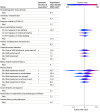A Precision Treatment Model for Internet-Delivered Cognitive Behavioral Therapy for Anxiety and Depression Among University Students: A Secondary Analysis of a Randomized Clinical Trial
- PMID: 37285133
- PMCID: PMC10248814
- DOI: 10.1001/jamapsychiatry.2023.1675
A Precision Treatment Model for Internet-Delivered Cognitive Behavioral Therapy for Anxiety and Depression Among University Students: A Secondary Analysis of a Randomized Clinical Trial
Abstract
Importance: Guided internet-delivered cognitive behavioral therapy (i-CBT) is a low-cost way to address high unmet need for anxiety and depression treatment. Scalability could be increased if some patients were helped as much by self-guided i-CBT as guided i-CBT.
Objective: To develop an individualized treatment rule using machine learning methods for guided i-CBT vs self-guided i-CBT based on a rich set of baseline predictors.
Design, setting, and participants: This prespecified secondary analysis of an assessor-blinded, multisite randomized clinical trial of guided i-CBT, self-guided i-CBT, and treatment as usual included students in Colombia and Mexico who were seeking treatment for anxiety (defined as a 7-item Generalized Anxiety Disorder [GAD-7] score of ≥10) and/or depression (defined as a 9-item Patient Health Questionnaire [PHQ-9] score of ≥10). Study recruitment was from March 1 to October 26, 2021. Initial data analysis was conducted from May 23 to October 26, 2022.
Interventions: Participants were randomized to a culturally adapted transdiagnostic i-CBT that was guided (n = 445), self-guided (n = 439), or treatment as usual (n = 435).
Main outcomes and measures: Remission of anxiety (GAD-7 scores of ≤4) and depression (PHQ-9 scores of ≤4) 3 months after baseline.
Results: The study included 1319 participants (mean [SD] age, 21.4 [3.2] years; 1038 women [78.7%]; 725 participants [55.0%] came from Mexico). A total of 1210 participants (91.7%) had significantly higher mean (SE) probabilities of joint remission of anxiety and depression with guided i-CBT (51.8% [3.0%]) than with self-guided i-CBT (37.8% [3.0%]; P = .003) or treatment as usual (40.0% [2.7%]; P = .001). The remaining 109 participants (8.3%) had low mean (SE) probabilities of joint remission of anxiety and depression across all groups (guided i-CBT: 24.5% [9.1%]; P = .007; self-guided i-CBT: 25.4% [8.8%]; P = .004; treatment as usual: 31.0% [9.4%]; P = .001). All participants with baseline anxiety had nonsignificantly higher mean (SE) probabilities of anxiety remission with guided i-CBT (62.7% [5.9%]) than the other 2 groups (self-guided i-CBT: 50.2% [6.2%]; P = .14; treatment as usual: 53.0% [6.0%]; P = .25). A total of 841 of 1177 participants (71.5%) with baseline depression had significantly higher mean (SE) probabilities of depression remission with guided i-CBT (61.5% [3.6%]) than the other 2 groups (self-guided i-CBT: 44.3% [3.7%]; P = .001; treatment as usual: 41.8% [3.2%]; P < .001). The other 336 participants (28.5%) with baseline depression had nonsignificantly higher mean (SE) probabilities of depression remission with self-guided i-CBT (54.4% [6.0%]) than guided i-CBT (39.8% [5.4%]; P = .07).
Conclusions and relevance: Guided i-CBT yielded the highest probabilities of remission of anxiety and depression for most participants; however, these differences were nonsignificant for anxiety. Some participants had the highest probabilities of remission of depression with self-guided i-CBT. Information about this variation could be used to optimize allocation of guided and self-guided i-CBT in resource-constrained settings.
Trial registration: ClinicalTrials.gov Identifier: NCT04780542.
Conflict of interest statement
Figures


References
-
- Ebert DD, Mortier P, Kaehlke F, et al. ; WHO World Mental Health-International College Student Initiative collaborators . Barriers of mental health treatment utilization among first-year college students: first cross-national results from the WHO World Mental Health International College Student Initiative. Int J Methods Psychiatr Res. 2019;28(2):e1782. doi:10.1002/mpr.1782 - DOI - PMC - PubMed
-
- Karyotaki E, Efthimiou O, Miguel C, et al. ; Individual Patient Data Meta-Analyses for Depression (IPDMA-DE) Collaboration . Internet-based cognitive behavioral therapy for depression: a systematic review and individual patient data network meta-analysis. JAMA Psychiatry. 2021;78(4):361-371. doi:10.1001/jamapsychiatry.2020.4364 - DOI - PMC - PubMed
-
- Furukawa TA, Suganuma A, Ostinelli EG, et al. . Dismantling, optimising, and personalising internet cognitive behavioural therapy for depression: a systematic review and component network meta-analysis using individual participant data. Lancet Psychiatry. 2021;8(6):500-511. doi:10.1016/S2215-0366(21)00077-8 - DOI - PMC - PubMed

